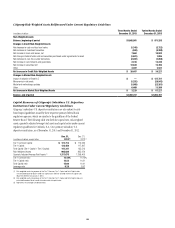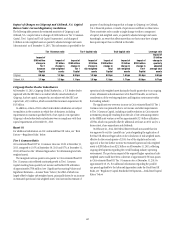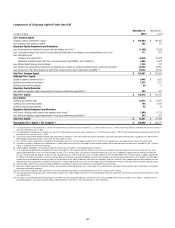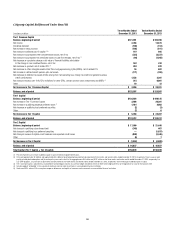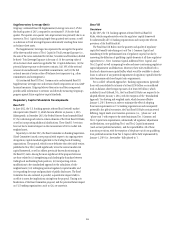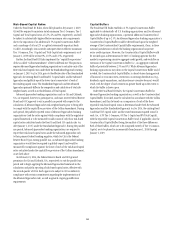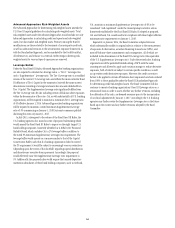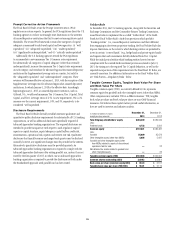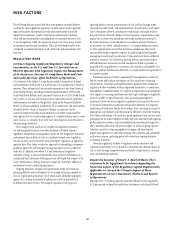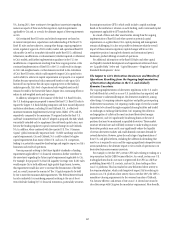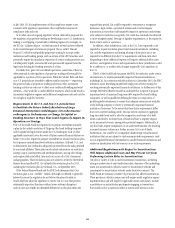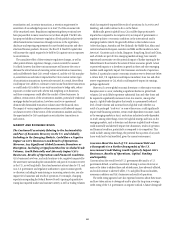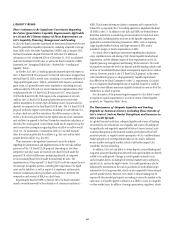Citibank 2013 Annual Report Download - page 72
Download and view the complete annual report
Please find page 72 of the 2013 Citibank annual report below. You can navigate through the pages in the report by either clicking on the pages listed below, or by using the keyword search tool below to find specific information within the annual report.54
Advanced Approaches Risk-Weighted Assets
The Advanced Approaches for determining risk-weighted assets amends the
U.S. Basel II capital guidelines for calculating risk-weighted assets. Total
risk-weighted assets under the Advanced Approaches would include not only
Advanced Approaches in calculating credit and operational risk-weighted
assets, but also market risk-weighted assets. Primary among the Basel II
modifications are those related to the treatment of counterparty credit risk,
as well as substantial revisions to the securitization exposure framework. As
with the Standardized Approach, and as mandated by the Dodd-Frank Act,
all references to, and reliance on, external credit ratings in deriving risk-
weighted assets for various types of exposures are removed.
Leverage Ratios
Under the Final Basel III Rules, Advanced Approaches banking organizations
are also required to calculate two leverage ratios, a “Tier 1” Leverage ratio
and a “Supplementary” Leverage ratio. The Tier 1 Leverage ratio is a modified
version of the current U.S. Leverage ratio and reflects the more restrictive Basel
III definition of Tier 1 Capital in the numerator, but with the same current
denominator consisting of average total assets less amounts deducted from
Tier 1 Capital. The Supplementary Leverage ratio significantly differs from
the Tier 1 Leverage ratio by also including certain off-balance-sheet exposures
within the denominator of the ratio. Citi, as with substantially all U.S. banking
organizations, will be required to maintain a minimum Tier 1 Leverage ratio
of 4% effective January 1, 2014. Advanced Approaches banking organizations
will be required to maintain a stated minimum Supplementary Leverage
ratio of 3% commencing on January 1, 2018, but must commence publicly
disclosing this ratio on January 1, 2015.
In July 2013, subsequent to the release of the Final Basel III Rules, the
U.S. banking agencies also issued a notice of proposed rulemaking which
would amend the Final Basel III Rules to impose on the eight largest U.S.
bank holding companies (currently identified as G-SIBs by the Financial
Stability Board, which includes Citi) a 2% leverage buffer in addition to
the stated 3% minimum Supplementary Leverage ratio requirement. The
leverage buffer would operate in a manner similar to that of the Capital
Conservation Buffer, such that if a banking organization failed to exceed
the 2% requirement it would be subject to increasingly onerous restrictions
(depending upon the extent of the shortfall) regarding capital distributions
and discretionary executive bonus payments. Accordingly, the proposal
would effectively raise the Supplementary Leverage ratio requirement to
5%. Additionally, the proposed rules would require that insured depository
institution subsidiaries of these bank holding companies, such as Citibank,
N.A., maintain a minimum Supplementary Leverage ratio of 6% to be
considered “well capitalized” under the revised prompt corrective action
framework established by the Final Basel III Rules. If adopted as proposed,
Citi and Citibank, N.A. would need to be compliant with these higher effective
minimum ratio requirements on January 1, 2018.
Separately, in January 2014, the Basel Committee adopted revisions
which substantially modify its original rules in relation to the measurement
of exposures for derivatives, securities financing transactions (SFTs), and
most off-balance-sheet commitments and contingencies, all of which are
included in the denominator of the Basel III Leverage ratio (the equivalent
of the U.S. Supplementary Leverage ratio). Under the revised rules, banking
organizations will be permitted limited netting of SFTs with the same
counterparty and allowed to apply cash variation margin to reduce derivative
exposures, both of which are subject to certain specific conditions, as well
as cap written credit derivative exposures. Moreover, the credit conversion
factors to be applied to certain off-balance-sheet exposures have been reduced
from 100% to those applicable under the Basel III Standardized Approach
for determining credit risk-weighted assets. The Basel Committee will also
continue to monitor banking organizations’ Basel III Leverage ratios on a
semiannual basis in order to assess whether any further revisions, including
the calibration of the ratio, are deemed necessary prior to the incorporation
of any final adjustments by January 1, 2017. Accordingly, the U.S. banking
agencies may further revise the Supplementary Leverage ratio in the future
based upon the current and any further revisions adopted by the Basel
Committee.




